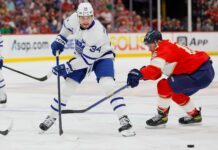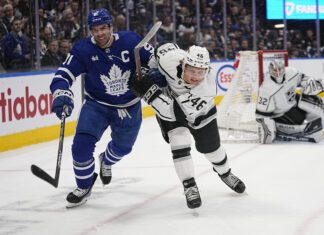The Maple Leafs need to figure out who their third-line center will be next season.
Alex Kerfoot, who is coming off a strong playoff series against Montreal, is certainly an option. However, the Leafs will have to decide whether or not they can protect him in the expansion draft, and given his $3.5 million cap hit, he’s a candidate to be moved even if he isn’t selected by Seattle.
Sheldon Keefe didn’t really have much of a third line this season. In an ideal world, Pierre Engvall and Ilya Mikheyev would be playing on the fourth line in behind a third line that can produce more offensively. If I was Kyle Dubas, I’d want a legitimate third-line center to play with Jason Spezza and a cheap center option to play with Engvall and Mikheyev. However, they rarely played Kerfoot with Spezza this season, so it remains to be seen what Dubas will decide to do.
One way or another, if Kerfoot leaves, we can expect the Leafs to add a center to help replace him. They could try to match his production for less, or they could even look to spend a little bit extra here and upgrade up the middle.
This article will explore their potential options, both via free agency and trade.
The Incumbent
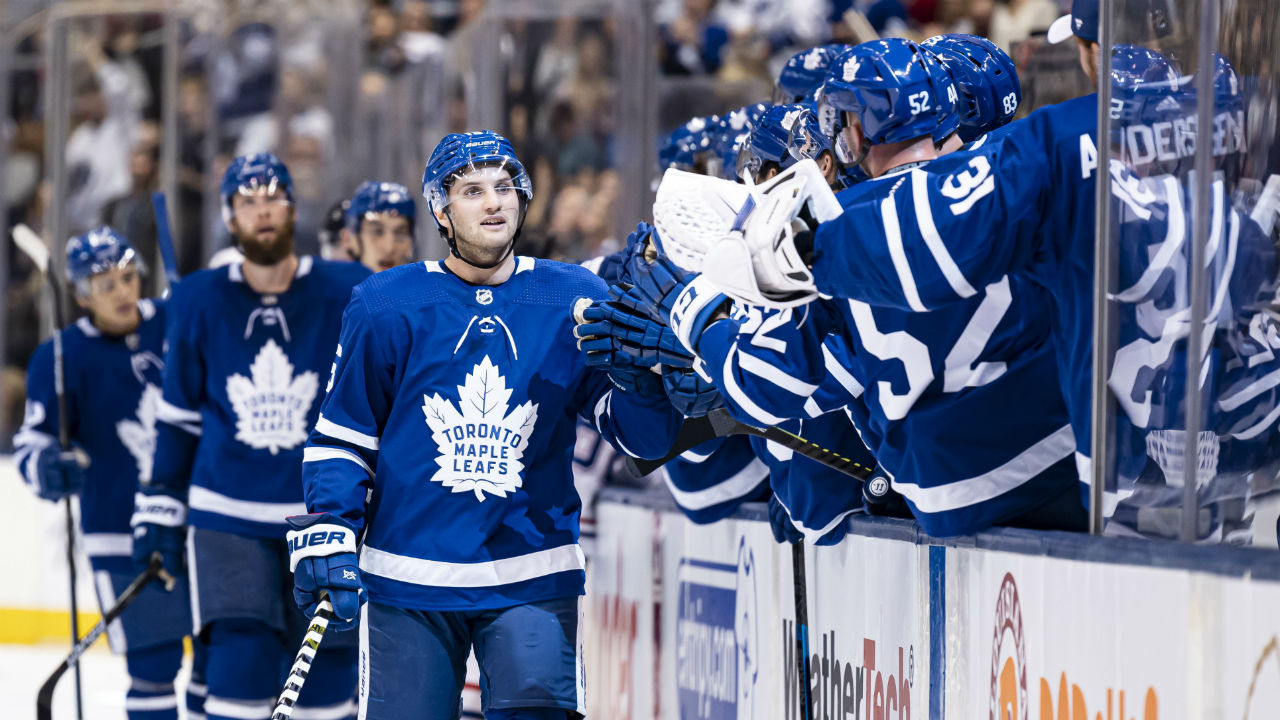
Alex Kerfoot (two years, $3.5M cap hit)
2021 Stats: 56 GP, 8 G, 15 A, 23 P (0.41 points per game)
It looks like the Leafs will need to decide between Kerfoot or Justin Holl when it comes to the expansion draft. Given Kerfoot’s $3.5 million salary, he could be the one on his way out the door. Even if Seattle went off the board and took Travis Dermott or Pierre Engvall, as we learned last year with Kasperi Kapanen and Andreas Johnsson, players in the $3-4 million range aren’t often safe in Toronto.
Kerfoot’s strengths are his versatility and playoff performances. He’s able to play on both special teams and he has no problem shifting over to the wing when needed. You can pencil him in on a scoring line with Tavares and Nylander, or have him center a checking line with Engvall and Mikheyev. He also was one of Toronto’s lone bright spots in the series against Montreal with six points in seven games (I also thought that he played quite well in the Columbus series).
His point totals aren’t inflated by power-play production, either — he’s scored at a solid rate at five-on-five throughout his time in Toronto (although that does include some time as a top-six winger). He’s a respectable transition player, but he’s not a shooting threat and only has three goals in 30 career playoff games under his belt. While he’s able to play on both special teams, he’s arguably not a big difference-maker on either unit.
The Leafs would have a tough time finding a cheap replacement for Justin Holl in the top four. As a result, I expect Kerfoot to be exposed in the expansion draft and to play close to home with Seattle next season.
The Leafs would then need to decide whether they want to spend more or less to fill the third-line center position. Based on Evolving Hockey‘s goals above replacement (GAR) or expected goals above replacement (xGAR), it looks like the Leafs can get more value elsewhere for their $3.5 million.
Free Agent Options
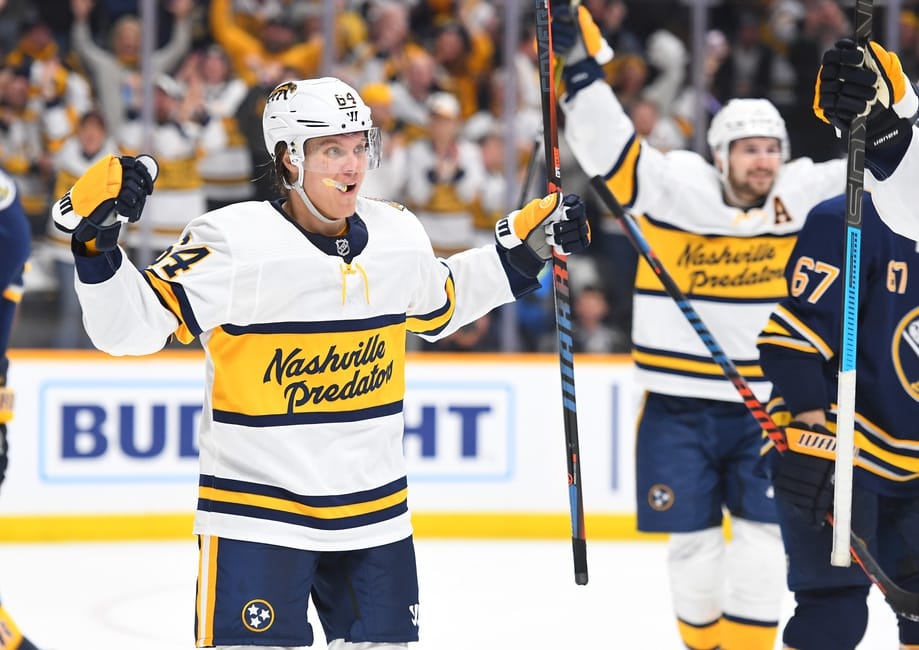
Mikael Granlund
2021 Stats: 51 GP, 13 G, 14 A, 27 P (0.53 points per game)
Granlund was linked to the Leafs both last offseason and at the trade deadline. Like Kerfoot, he’s 5’10”, shoots left, plays on both special teams, and rotates between center and wing. Also like Kerfoot, he’s coming off a strong playoff performance and is more of a playmaker than a goal scorer.
Granlund carries more offensive upside — he scored at a 69-point pace per 82 games over his final three seasons in Minnesota — but he has fallen to around the .5 points-per-game mark during his two seasons in Nashville. Given that he’s still only 29, it’s certainly possible that he could return to the Minnesota version of himself.
The Finnish forward spent the majority of the 2021 season at center, where he was slightly above average in the faceoff circle. Evolving Hockey‘s RAPM did not like his defensive game down the middle this season, but he was playing in a top-six role and the competition he faced the most included Joe Pavelski, Patrick Kane, Sebastien Aho, Anthony Mantha, and Roope Hintz. The question becomes: Is Granlund weak defensively at center, or would his defensive results improve if he moved out of the top six?
As a free agent last offseason, he ended up signing a one-year deal at $3.75 million. I expect him to get a bit of a raise given how good he was in the playoffs, and I wouldn’t be surprised if Nashville ponies up to keep him. However, if he does hit the open market, the Leafs could offer him a multi-year contract around the $4 million range and use him as a third-line center or second-line winger based on what their needs are this season.
Looking at GAR and xGAR, if you get the Minnesota version of Granlund, you’re getting one of the steals of the offseason. If you get the Nashville version of Granlund, you might be replacing Kerfoot with his clone.
In my view, Granlund is a good underrated player, but I’m not 100% convinced that he’s better off at center compared to the wing. I do believe he’s talented enough to be successful in a third-line center role, but he could also be a player who starts as a top-six winger and moves to center if an injury occurs down the middle.
Alex Wennberg
2021 Stats: 56 GP, 17 G, 12 A, 29 P (0.52 points per game)
After Wennberg was bought out by Columbus last offseason, the Panthers smartly scooped him up on a one-year deal worth $2.25 million. His shooting percentage was about double his career norm, so don’t expect him to score at a 25-goal pace (per 82 games) again, but he’s scored at a 40-point pace over his NHL career. Given that he’s only 26, he should have a handful of years left in the NHL. A multi-year deal is likely.
In terms of Evolving Hockey‘s goals above replacement, Wennberg has provided similar value to Granlund over the past five seasons, but he didn’t produce much during his final seasons with Columbus. He’s 6’2″, played on the penalty kill for the Panthers, and he is slightly below average in the faceoff circle. He’s certainly due for a raise on the $2.25 million he made last season, but I’ll be surprised if he gets significantly more than Kerfoot’s $3.5 million.
Wennberg and Granlund are quite similar. Like Granlund, he graded out as an extremely valuable player four or five seasons ago but fell off a bit recently. He recorded a 59-point season in 2016-17, and given that he’s still only 26, there’s no age-related reason as to why he declined. His offensive value exceeds his defensive value, but he could be a strong bottom-six playmaker to pair with players like Jason Spezza and Nick Robertson.
Wennberg found plenty of chemistry with William Nylander at the 2019 World Championships, and he could jump up into the top six if an injury occurred. Given how well his season went in Florida, there’s a good chance that the Panthers will try to re-sign him. However, if he does hit the open market, he should certainly be on the short-list if the Leafs need to replace Kerfoot.
Nick Bonino
2021 Stats: 55 GP, 10 G, 16 A, 26 P (0.47 points per game)
Bonino won two Cups as the third-line center for the Pittsburgh Penguins. Even at age 33, he continues to be a fairly productive player. You can typically count on him for 35 points or so, in addition to strong grades defensively. He’s pretty strong in the faceoff circle, kills penalties, and can exist on a second powerplay unit. It seems like he’s been a solid third-line center forever.
Paid $4.1 million on the cap last season, Bonino was traded by the Nashville Predators along with some draft capital to the Wild for Luke Kunin. Given that Bonino ended up on the wing come playoff time — and the fact that Minnesota’s other four centers appear set to return — it’s easy to envision him hitting the open market. He’ll likely have to take a pay cut, and given his age, he’ll likely only receive a one- or two-year deal.
Bonino is pretty much a God by GAR and xGAR. He’s the best player on this list by these numbers, and since he won’t be the most expensive, he could end up being a bit of a steal. The Leafs could use him on a checking line with players like Engvall and Mikheyev, or with offensive players like the Penguins did when he played with Kessel. He’s always had a strong shooting percentage thanks to an ability to get to the net.
The only question with Bonino is in terms of his age — he’ll be 34 by the time next year’s playoffs roll around. It’s possible that his play takes a step back. However, he’s still putting up more points per minute at five-on-five than Kerfoot and he still grades out well defensively.
Bonino probably won’t be the player on this list who breaks out with a 50+ point season, but by the numbers, it certainly looks like he’s one of the best candidates for the job.
Phillip Danault
2021 Stats: 53 GP, 5 G, 19 A, 24 P (0.45 points per game)
This one feels like a bit of a long shot. Given Montreal’s playoff success, the team’s lack of high-end centers, and the fact that he’s a Quebec native, I expect him to re-sign with the Habs. However, if he does hit the open market, the Leafs could make an offer in an attempt to upgrade up the middle. He’d certainly make an excellent third-line center.
Danault scored at over a 50-point pace in both the 2018-19 and 2019-20 seasons, but his offensive production took a step back this season thanks largely to a 6.8% shooting percentage. He’s known as an excellent defensive forward — statistics like Evolving Hockey‘s RAPM certainly backing that up, and he grades out quite well by GAR and xGAR. If you’re only making your decision based on the numbers, though, you’re probably preferring Bonino for less money.
Danault will be 29 in February and seems bound to sign a long-term deal. He’ll probably cost over $5 million per year — and if not, close to it — as he’s closer to a second-line center than a third liner.
The Leafs would basically be choosing to spend heavily at the center and would then presumably go cheaper on the wings. Given Toronto’s lack of cap space, adding Danault does not seem overly likely, although I suppose they could see him as an alternative if Hyman walks.
Paul Stastny
2021 Stats: 56 GP, 13 G, 16 A, 29 P (0.52 points per game)
Stastny will be 36 in December, but he continues to grade out fairly well by RAPM. He’s not scoring at the same rate at five-on-five as he used to — he also spent some time on the wing this season — but he still ended up scoring at a 42-point pace. He’s actually scored above a 40-point pace for 16 straight seasons, so if you’re looking to add some offense into your bottom six, it’s tough to argue against Stastny.
He is also a 54-55% player in the faceoff circle who you can use as a left-handed faceoff specialist on the penalty kill. After carrying a $6.5 million cap hit this season, given his age and drop in production, he’ll have to take a steep pay cut.
I’d rather target someone a bit younger, but if he’s cheap enough on a one-year deal, the Leafs have to at least consider it. He might end up staying in Winnipeg, so I think this one is a bit of a long shot.
Tyler Bozak
2021 Stats: 31 GP, 5 G, 12 A, 17 P (0.55 points per game)
Leafs fans are already familiar with Bozak, who is now a Stanley Cup champion after signing a three year deal with the Blues in 2018. He can still bring a fair amount of secondary scoring to the table, but he’ll be 36 by the time next year’s playoffs start and he’s never been known for the defensive side of his game. Unless he’s taking a big discount to return to Toronto, it’s tough to see a fit here.
If you’re basing your decision based strongly on GAR or xGAR, Bozak probably isn’t the player that you’re targeting. While he could chip in on the second power-play unit and in the faceoff circle, I just don’t think that he’s the five-on-five play driver that the Leafs are looking for.
The Leafs already have a right-shooting veteran center who brings plenty of offensive production to the table in Jason Spezza. Bozak spent some time on the wing this season, and I wouldn’t be surprised if that happens more and more in the future. I won’t rule it out completely, but Bozak doesn’t look like a fit.
Derek Ryan
2021 Stats: 43 GP, 2 G, 11 A, 13 P (0.3 points per game)
Ryan scored two goals this season, so if the Leafs really want to go cheap here, he could be a good option. He’ll be 35 in December, but he still grades out well by Evolving Hockey‘s RAPM and he’s just one season removed from scoring at a 35-point pace. The Leafs were rumoured to be interested in him a few years ago. Like T.J. Brodie, the second time around could be the charm.
Ryan is strong in the faceoff circle and kills penalties. He’s one of those players who always looks better by the numbers than you’d expect — the Flames outscored their opponents 82-52 (62%) during his five-on-five minutes over three seasons. I’m definitely interested in signing him for cheap, but he projects more safely as a fourth-line center than a third-line one.
Like Bonino, he grades out better than you’d expect by GAR and xGAR, but his age is a bit of a concern. I don’t think he’s someone who can jump up to the top six if Matthews or Tavares gets hurt. Ryan is on my free-agent wish list, but I see him as a fourth-line pivot who can move up to the third line when needed.
Casey Cizikas
2021 Stats: 56 GP, 7 G, 7A, 14 P (0.25 points per game)
Cizikas is more like a prototypical fourth-line center, but I’m sure that there are plenty of Leafs fans out there who want him because of his physicality and defensive play. A solid player by both GAR and xGAR as well, he always grades out well defensively. He’s not going to provide as much offensively as the majority of players on this list, but he can certainly take plenty of defensive-zone starts and match up against just about anyone.
The main problem with Cizikas is cost. He carried a $3.35 million cap hit this season, and given the Islanders’ success in the playoffs, I don’t see him taking much of a pay cut. He’s spent his whole career with the Islanders and might not even hit the open market. Now 30 years old, given his style of play, I’m not sure that the Leafs will want to give him a long-term contract north of $3 million if he does.
I don’t think the Leafs are in a position where they can get in a bidding war over him. After experiencing significant problems scoring against both Columbus and Montreal, Cizikas wouldn’t help to address that need. I actually think that he’s a solid overall contributor, but if I’m dishing out north of $3 million, I want someone who can step up into a top-six role when needed.
Trade Options
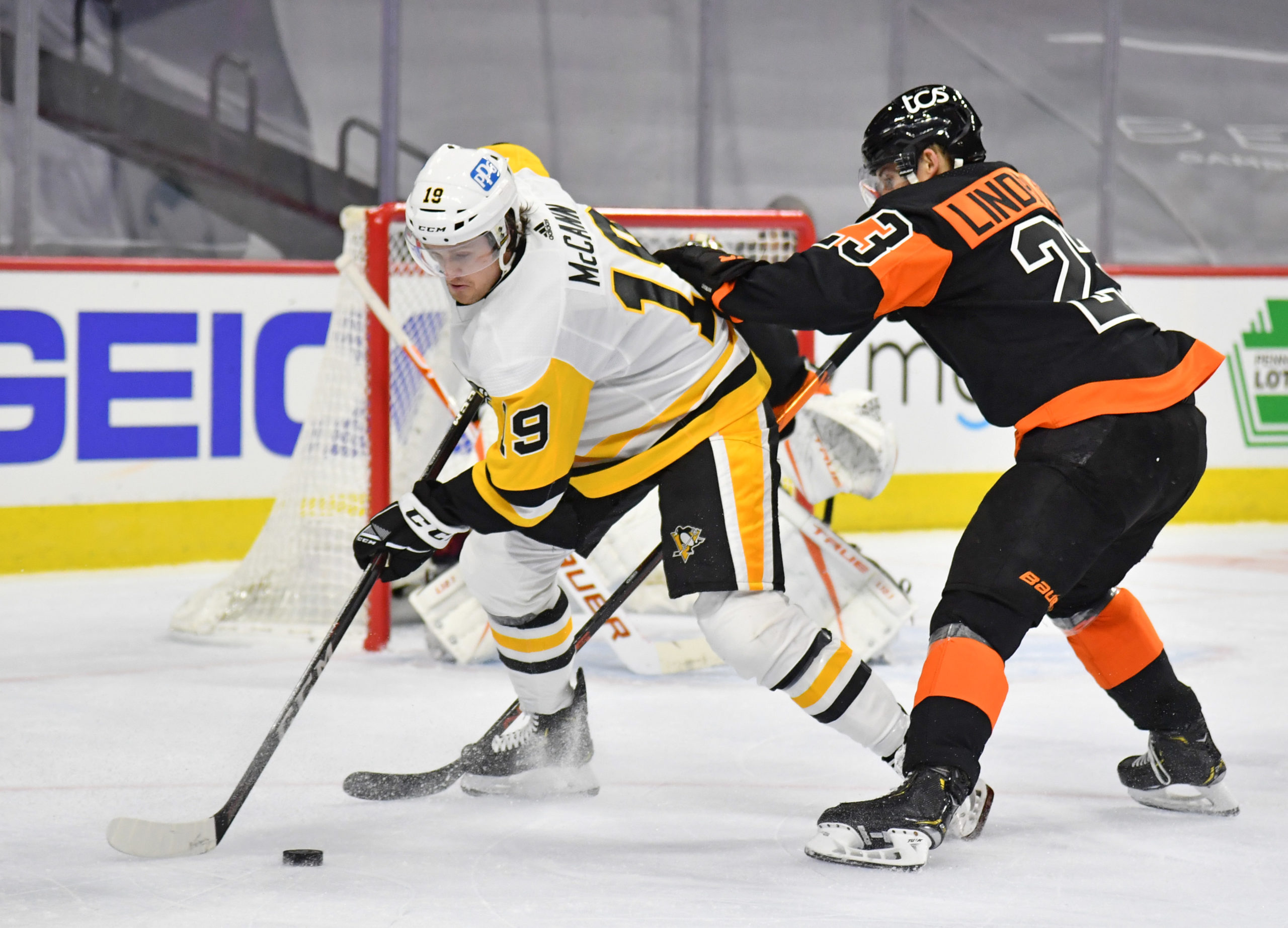
Jared McCann (One-year, $2.94 million, expires RFA)
2021 Stats: 43 GP, 14 G, 18 A, 32 P (0.74 points per game)
I’ve wanted the Leafs to trade for McCann for years, but after scoring at a 61-point pace this season, it might be too late. I’m not sure if the Penguins would even give him up for one year of Morgan Rielly, but he’s the type of well-rounded player that the Leafs should be kicking tires on.
McCann was a bit of an advanced stats God this year, finishing second in the NHL in Evolving Hockey‘s goals above replacement (GAR) behind only Connor McDavid. While I certainly don’t see him as an elite player, I’ve always thought that he was a good, underrated forward.
The 25-year-old has spent most of his time on the wing in recent seasons, but he started his career as a center, leading me to believe he can handle a role up the middle. Kyle Dubas and Sheldon Keefe are very familiar with him from his time with the Soo Greyhounds. I don’t think the Penguins will give him up easily, but he could help any team.
If you do trade for McCann, the question becomes: Should you use him as a top-six winger or a third-line center? 6’1″ and fairly physical, given his offensive production, McCann would be a good candidate to help replace Zach Hyman. While he’s not great at faceoffs, I think he’s more than capable of being a solid third-line center as well.
Ultimately, his trade cost might be too rich at the moment.
Dylan Strome (One-year, $3M AAV, expires RFA)
2021 Stats: 40 GP, 8 G, 9A, 17 P (0.43 points per game)
Leafs fans should be very familiar with Strome, as half the fanbase was praying that he would fall to the Leafs pick at fourth overall in the 2016 NHL Draft. Arizona ended up taking him at third overall, but he was traded to Chicago before he even played 50 NHL games. While he did put up 51 points in 58 games while playing with Patrick Kane a couple of seasons ago, he fell short of the 0.5 points-per-game mark this year.
Strome is below average defensively and won’t help you on the penalty kill. However, he’s still just 24 and the offensive skill has always been there. His skating has always been his weakness, but like Galchenyuk, the Leafs’ development staff could certainly help him in that regard.
Strome is a fine player for $3 million who isn’t a bad buy-low option, but I wouldn’t exactly trade a haul for him. If you’re basing your decision on GAR and xGAR, he’s probably not the player that you’re targeting, especially when you consider what you’d have to give up to get him.
While he would certainly help to bring some secondary scoring to the table, it’s questionable whether he fits the Leafs’ needs. He does have some offensive potential, so he could be worth a call, but I think this one is a bit of a long shot.
Cody Glass (One-year, $863k, expires RFA)
2021 Stats: 27 GP, 4 G, 6 A, 10 P (0.37 points per game)
Glass is similar to Strome in that he’s a former top draft pick who hasn’t lived up to expectations thus far. He continued to dominate the WHL after his draft year and also produced at the AHL level, but he’s certainly not at the same level as Suzuki or Necas (two players who were drafted after him). He’s 6’3″ and just turned 22, so you’d be hoping for him to have a breakout season next year. He hasn’t been a regular in Vegas’ playoff lineup.
Like most young forwards, he’s weak on faceoffs and doesn’t kill penalties. However, it’s always been clear that he’s quite skilled, and it seems like only a matter of time until he’s a regular at the NHL level. Replacing Kerfoot with an entry-level contract would help them to spend more elsewhere, but they’re trying to contend next season and they’d be betting on him to take a big step forward.
I still believe that Glass will be a solid NHL contributor who may even be a full-time NHL player as soon as next season. He’d certainly add some secondary scoring to the lineup with the ability to chip in on the power play.
The cost to acquire Glass would be quite high, though, and I’m not 100% sure if I’d end up wanting to play him on the wing (at least for next season). This one is a bit of a long shot, but if the Leafs move Morgan Rielly, he’s the type of young player Kyle Dubas could look at.
Jason Dickinson (RFA)
2021 Stats: 51 GP, 7 G, 8 A, 15 P (0.29 points per game)
Dickinson is a 6’2″ center who grades out well defensively, but he has yet to score at a 30-point pace. I don’t think the Stars are overly eager to move him, but the Stars could have some holes to fill on their blue line if Jamie Oleksiak and Sami Vatanen depart in free agency, and the Leafs could deal from their depth on defense.
Dickinson is weak on faceoffs but does kill penalties and can be trusted against top competition. While he’s not at Bonino’s level, he actually grades out quite well in terms of GAR and xGAR.
There’s certainly a chance that he’s better than Kerfoot while also having a lower cap hit. He’s perhaps a little bit too similar to Pierre Engvall, but he’s a solid player. His cap hit should be fairly low — that certainly fits with the Leafs’ needs — but I don’t think that the Stars move him unless they get a player that they really like in return.
Other Options
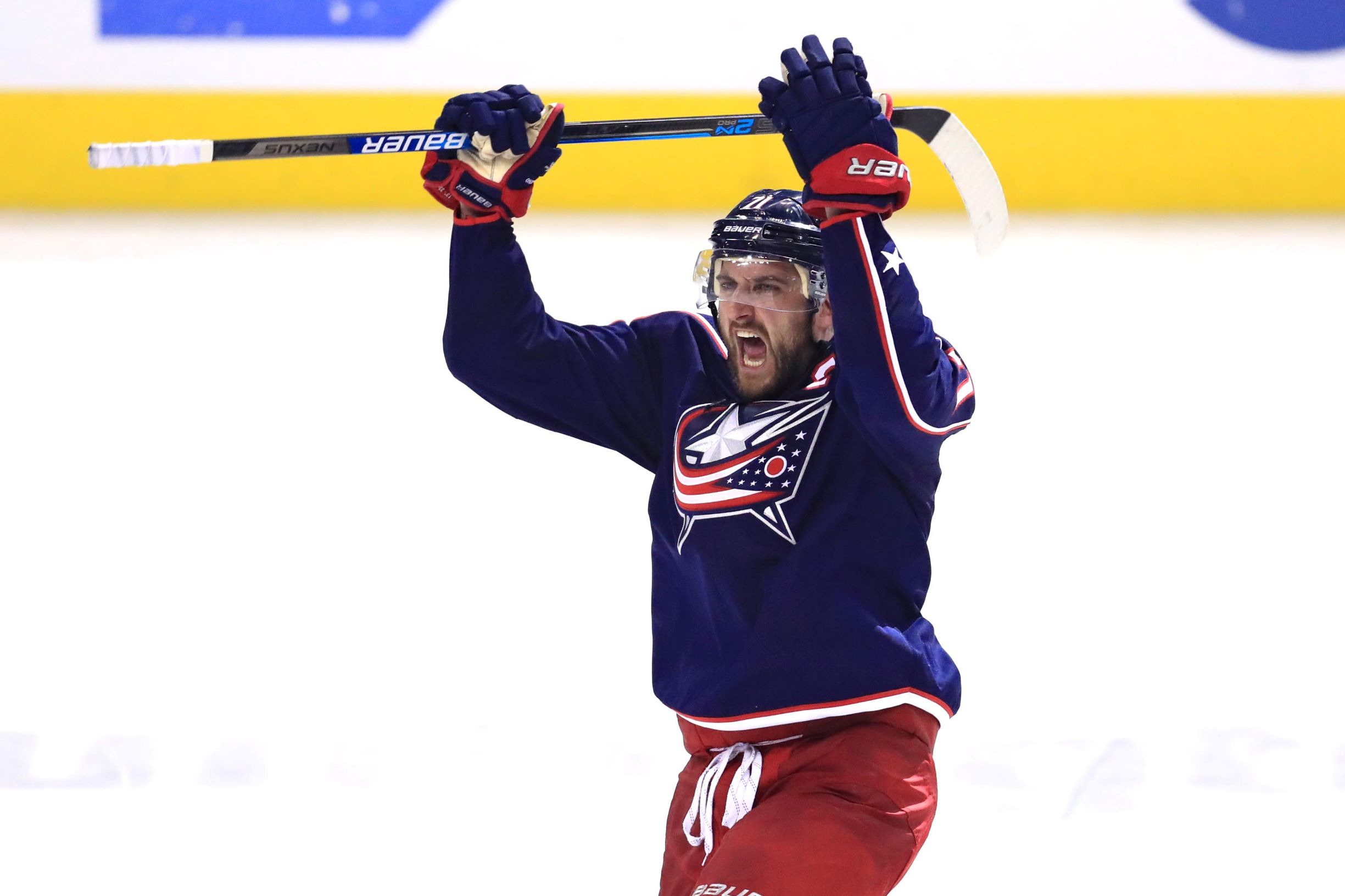
All the players in this section are long shots, but I’ll quickly run through them.
Ryan Nugent-Hopkins and David Krejci will simply be too expensive. I don’t see the Leafs engaging in a bidding war for them; I’d be quite surprised if they spent that heavily on a free agent center. Trading for the final year of Tomas Hertl’s contract is quite unlikely as well, but I will say that I’m a big fan of his.
I’d have interest in both Nick Schmaltz and Colin White if they were bought out. Similar to the Wennberg situation last offseason, the team would only have to pay one-third of the remaining value given their age. As of this moment, it looks like neither player will be bought out, and it’s tough to envision Ottawa or Arizona retaining salary in a trade. They’re worth looking into, but the Leafs can’t take on their full contract. Both appear to be long shots.
I suppose that Ryan Getzlaf and Eric Staal are possibilities if they wanted to take a big discount to come to Toronto. Staal is coming off of a rough season, and if the Leafs really liked him, they could have traded for him at the deadline. Even if either signs with the Leafs, I still think the team will be interested in adding another center if Kerfoot leaves. They’re more of a Thornton replacement rather than a Kerfoot replacement, and I’m not sure that the Leafs want to go down the aging veteran path so heavily again.
I see Nick Foligno as more of a winger who is not scoring a ton these days. He’ll probably end up back in Columbus (where his family is based), especially knowing he would have to take a discount for this to make much sense for Toronto. Even if he does sign with the Leafs, I probably wouldn’t pencil him in as the third-line center.
It seems like Derek Stepan wants to play south of the border, so he’s probably not an option. Chris Tierney carries a $3.5 million cap hit for next season and plays for a team that is unlikely to retain salary (Ottawa). Radek Faksa is signed for the next four seasons at a $3.25 million cap hit and hasn’t graded out well by the numbers in recent years. Trading for him would be a pretty large gamble.
Nick Bjugstad, who hasn’t done much since the 2017-18 season, might be better suited to play on the wing. Marcus Johansson, who just broke his arm in the playoff series against Vegas, could make sense for around the league minimum. However, like Bjugstad, he might be better off on the wing, and the Leafs may need another third-line center option even if they signed him.
I’ll throw Max Domi’s name out there as well, but he carries a $5.3 million cap hit for next season, which is likely too pricey.
The Leafs tried to sign Evan Rodrigues last offseason, so maybe they try again. However, he’s probably better off on the wing. If he is going to play center, the Leafs would probably want him to start on the fourth line rather than the third.
Vladislav Namestnikov was also linked to the Leafs last offseason, but he hasn’t graded out overly well by GAR or xGAR and he’s under contract with the Red Wings for a $2 million cap hit next season. He’s a fine depth player, but I wouldn’t give up a ton to trade for him.
Robert Thomas was pretty much untouchable last offseason, but given that he only scored three goals this year, there’s at least a chance he’s available. He’s a good player and only 21, but I just don’t see him getting traded.
Alex Texier is also only 21 and offers intriguing potential, but he’s 36% in the faceoff circle and needs to improve defensively. I don’t see why Columbus would want to move 21-year-old forwards in their current situation.
Haula and Soderberg are better suited for a fourth-line role. Trading for one year of Nazem Kadri would sure be interesting, but that’s probably not happening. I like Tyson Jost, but so does Colorado, and it seems tough to win a trade with them these days.
Final Thoughts
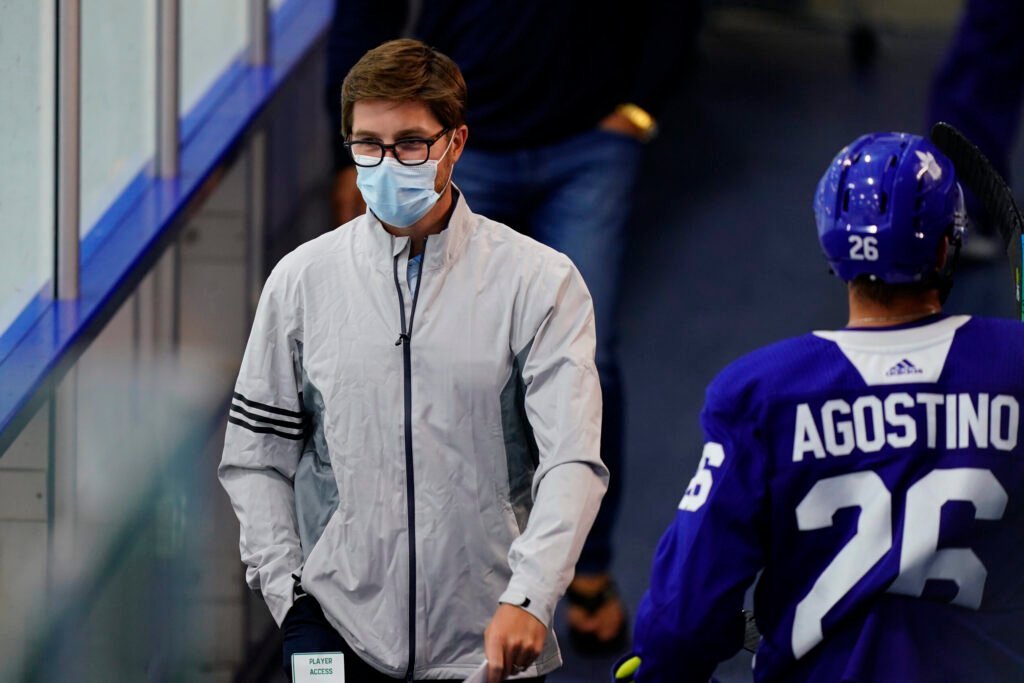
Don’t expect to be completely blown away by Toronto’s third-line center next season. If this team makes a big splash, it’s far more likely to be on a winger. However, upgrading up the middle would certainly be nice, even if it’s a small upgrade. Saving $500k to help the team elsewhere would also be nice, especially if the new addition is also an upgrade on Kerfoot.
Bonino, Wennberg, and Granlund seem like the most likely options if Kerfoot departs. Bonino grades out extremely well by GAR and xGAR, has been a good third-line center for years, and his cap hit probably ends up cheaper than Kerfoot’s $3.5 million. He’s versatile and can play in any situation.
Wennberg might stay in Florida, but he could create plenty of offense on a line with Jason Spezza. He could also move up to the top six if needed. A line of Robertson, Wennberg, and Spezza could beat up on weaker competition, followed by Engvall and Mikheyev in a more traditional shutdown line.
Granlund could make a lot of sense, but I’m not sure if the Leafs view him as a winger rather than a center. It’s always nice to have players who can shift over to the center when needed, and even if they sign another player on this list, I could still see the Leafs being interested in this player. We know the Leafs like him.
Of course, this article will be completely irrelevant if the Leafs trade for Jack Eichel and rotate Matthews, Tavares, and Eichel around four sets of wingers.





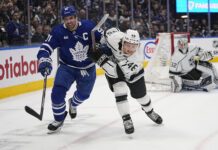
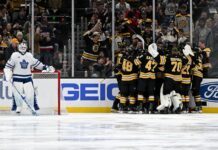
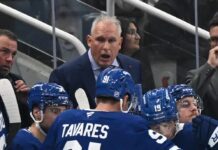




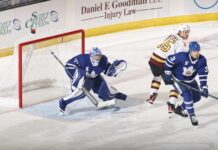

![John Gruden after the Leafs prospects’ 4-1 win over Montreal: “[Vyacheslav Peksa] looked really comfortable in the net… We wouldn’t have won without him” John Gruden, head coach of the Toronto Marlies](https://mapleleafshotstove.com/wp-content/uploads/2025/09/gruden-post-game-sep-14-218x150.jpg)





